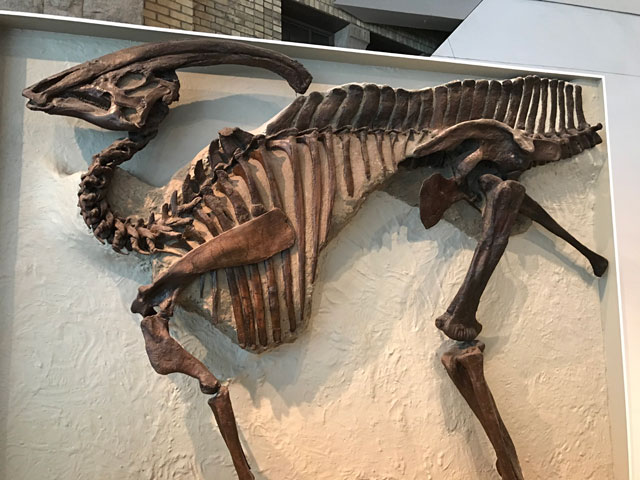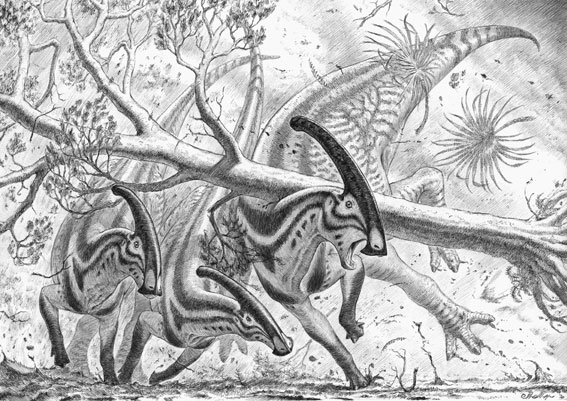An Unlucky Parasaurolophus – ROM 768
A study of the holotype of the iconic duck-billed dinosaur Parasaurolophus (P.walkeri) has revealed that some of these dinosaurs led very tough lives. Tell-tale evidence preserved in the fossilised bones suggest that this particular specimen ROM 768, suffered a major trauma, but survived, at least for a little while after the incident.
PhD student Filippo Bertozzo from the School of Natural and Built Environment at Queen’s University Belfast, examined the skeleton of the Parasaurolophus which has been on display at the Royal Ontario Museum (Canada). The articulated specimen (ROM 768), represents the almost complete remains of an adult animal, only elements from the lower limbs and the tail are missing.
The fossils were discovered in 1920 in Upper Cretaceous sediments exposed along the Red Deer River of southern Alberta. The material represents the first fossils of the genus Parasaurolophus to be reported and studied.
The Iconic Parasaurolophus Skeleton on Display at the Royal Ontario Museum (ROM 768)
Picture credit: Queen’s University Belfast
Parasaurolophus – Injured by a Falling Tree
The morphology of the dinosaur’s neck had long intrigued scientists and scientific illustrators. Once thought to have a graceful, swan-like neck most palaeontologists now think that Parasaurolophus had a thick, bulky neck, one capable of supporting that huge, hollow crest for which this dinosaur is famous for.
Student Filippo explained:
“Our research using paleopathological markers, which help us study the diseases of ancient humans and fossil animals, means we are now fairly certain how this iconic dinosaur would have really looked. The ROM 768 suffered numerous injuries which suggest a major incident of trauma before its death and we think a heavy object such as a tree may have fallen on top of the animal, perhaps during a storm.”
A Dramatic Incident for One Particular Dinosaur
Picture credit: Supplied by Queen’s University Belfast
Reconstructing the Neck of an Ornithischian Dinosaur
The research has shown that members of the Ornithopoda, including duck-billed dinosaurs, iguanodonts and other related genera were prone to a number of injuries and diseases.
Commenting on ROM 768, the PhD student added:
“Damage to the muscles resulted in a disc-shaped overgrowth on the tip on the bony part of one its vertebrae in its neck. We interpreted the disc as a secondary enlargement of the base of the nuchal ligament, a large elastic structure that supports the neck and the head. This enabled us to reconstruct the anatomical structure of the neck, revealing that it was strong and muscular to support its head.”
The study of the iconic Parasaurolophus specimen revealed broken bones in the pelvis, ribs and spine. The scientists also found evidence of a lesion in the mouth that may have been caused as a result of a heavy object falling on the animal.
The injuries show signs of healing, demonstrating how tough and resilient these types of dinosaurs were. The Parasaurolophus (ROM 768), survived for several months or perhaps some years after the traumatic event.
Professor Eileen Murphy, a bioarchaeologist in Queen’s, stated:
Palaeopathology has been a relatively neglected aspect of palaeontology until recent years. The study of ROM 768 clearly demonstrates the value of this approach for reconstructing the quality of life of dinosaurs and the threats from the natural environment they may have faced on a daily basis.”
Everything Dinosaur acknowledges the assistance of a media release from Queen’s University Belfast in the compilation of this article.
Visit the Everything Dinosaur website: Everything Dinosaur.








i love learning about them